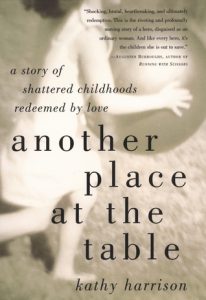
People become foster parents for a variety of reasons. In Another Place at the Table, Kathy Harrison writes that her career as a foster parent began because of her relationship with one child. Kathy was a teacher with Head Start when she met Angelica, a four-year-old foster child with sad prospects. Angie’s mother was a drug addict with health problems. She had little hope of ever being able to care for Angie. In addition, Angie’s foster family was unable to tolerate her behavior, so they were going to send her away. Kathy talked with her husband Bruce about Angie’s situation, and as Kathy explains,
“I’m not sure when ‘can we’ changed to ‘how can we’ and then to ‘how can we not’, over the course of a few weeks, but it did.”
Six months after the Harrisons brought Angie into their home, they also welcomed her younger sister, Neddy.

When Kathy and Bruce adopted both girls, they thought their family was complete. With three biological sons and two adopted daughters, they did not plan to foster any more children. However, over time, their ability to say no to the calls they received from the Department of Social Services diminished. Kathy says,
“It wasn’t that I wanted or needed any more children. It was just that every story was so darn sad, and I always did suffer from an overactive imagination.”
Thus, the Harrisons’ more than thirteen years as foster parents began.
In Another Place in the Table, Kathy tells the stories of some of the children out of almost a hundred the Harrisons fostered. In the introduction, Kathy explains that her intent is not to shock her readers, but her story both shocked and terrified me the first time I read it two years ago. For example, Kathy describes finding two women overdosed – one dead – during a visitation, and she recounts how two children under her care were molested by Sara, a six-year-old Kathy couldn’t give up on until she absolutely had to. With some of the children, the Harrisons didn’t know what they were getting into until it was too late. As Kathy puts it,
“When we first said yes to the foster care system, we unlocked the door and let the snake in.”
Despite my strong reaction to the book, I felt drawn back to it as I considered what to cover in these reviews. I decided to read it again, and I wasn’t shocked during the second reading. I’m not sure why. Maybe since I already knew the story, it didn’t surprise me as much. Maybe I was a little more mature and realistic, for I was quite idealistic when I first started learning about the foster system. Or maybe getting to know foster parents made me more aware of what foster care was like.
With the shock behind me, I was open to experience the story in more depth. It enchanted me, and I couldn’t put it down. I was amazed by Kathy and Bruce’s courage in tackling tough cases. I loved the children as I saw them through Kathy’s eyes, and I was touched by their desire to simply be children despite the worst odds against them. I respected Kathy’s honesty, how she describes her failures, resists making excuses for them, and doesn’t try to paint herself as a saint. As a character, she is totally relatable – a normal, everyday person trying to do a tough job she isn’t sure she knew how to do.
If you think you might consider fostering, I challenge you to read Another Place at the Table, maybe twice. Obviously, every person and situation is different, so your experience of foster care might not be anything like the Harrisons’. However, this book will allow you to encounter foster care on a personal level you can’t get from a manual or a class. You will learn:
Fostering means knowing about things most of us would prefer to forget. It means recognizing that our best is often not good enough. It means only knowing the difficult beginnings of a story and being forced to imagine the end. It means loving children who will ultimately leave us, then drying our tears and letting ourselves love again.
Another Place at the Table
Nonfiction by Kathy Harrison
Jeremy P. Tarcher/Putnam, 2003





